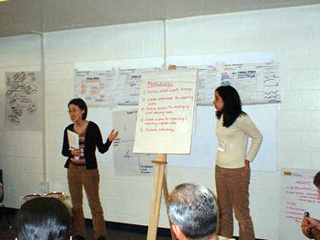
Students Tam Doan and Tara Kumar presenting to the community. (Photo courtesy of Wai Kin Lee.)
Instructor(s)
Prof. Ceasar McDowell
MIT Course Number
11.310J
As Taught In
Fall 2002
Level
Graduate
Course Description
Course Highlights
This class teaches digital tools to urban designers, showing them how these tools can be effective in their work in communities. It includes tutorials on these tools, and a list of resources helpful to learning digital storytelling techniques.
This class is run through the Center for Reflective Community Practice (CRCP), which is the newest Center in the Department of Urban Studies and Planning at MIT. CRCP is built on the 25-year legacy of Mel King and the Community Fellows Program at MIT.
Four central goals orient CRCP's work: helping people know what they know, improving community practice through reflection and learning, building grounded knowledge from reflection on practice, and developing tools and technology to support this work. We have examined the last several years of work and learning, and identified a set of questions that are critical for carrying out these goals. Through two broad areas of work, direct work with communities, and making practitioner knowledge accessible, we seek to advance our learning around those questions. Over the next several years, we see CRCP moving to the next level in our work: to function as a network of growing experience, knowledge, and tools for helping struggling communities use their knowledge resources as capital in the improvement of community life.
Course Description
This workshop explores the potential of media technology and the Internet to enhance communication and transform city design and community development in inner-city neighborhoods. The class introduces a variety of methods for describing or representing a place and its residents, for simulating actions and changes, for presenting visions of the future, and for engaging multiple actors in the process of envisioning change and guiding action. Students will engage one neighborhood, meet real people working on real projects, put theory into practice, and reflect on insights gained in the process.
This year the course will examine what it means to be an urban designer/planner and how to create a digital teaching tool (using digital storytelling) that supports others in learning about the relationship between design and planning professionals, on the one hand, and members of the communities they serve, on the other. What is the nature of the knowledge that resides in a community and how can designers and planners learn about, tap, and use that knowledge? What is the relationship between community organizing and urban design and planning? What are the relationships between you as a professional, the place(s) in which you work, and the values and care you bring to that work?
We will explore these themes in the context of Camfield Estates in Lower Roxbury, MA and its participation in the US Department of Housing and Urban Development's (HUD) Demonstration Disposition Project. There have been many stories written about Camfield Estates' participation in the Demonstration Disposition project, for it has been widely regarded as a model of success. There are two stories that have not yet been told, however: the story of the residents who organized the community and the story of the architects and planners who participated in the project. This course will use digital storytelling to reconstruct and connect these two stories.
Other Versions
Other OCW Versions
OCW has published multiple versions of this subject. ![]()


